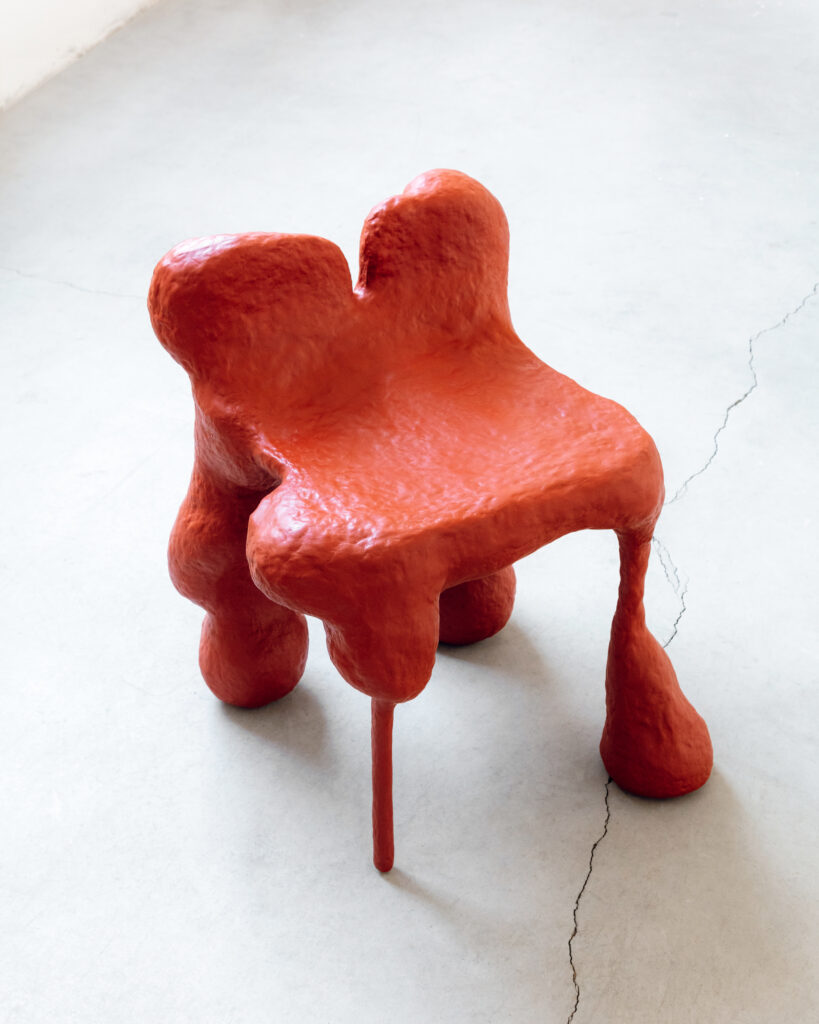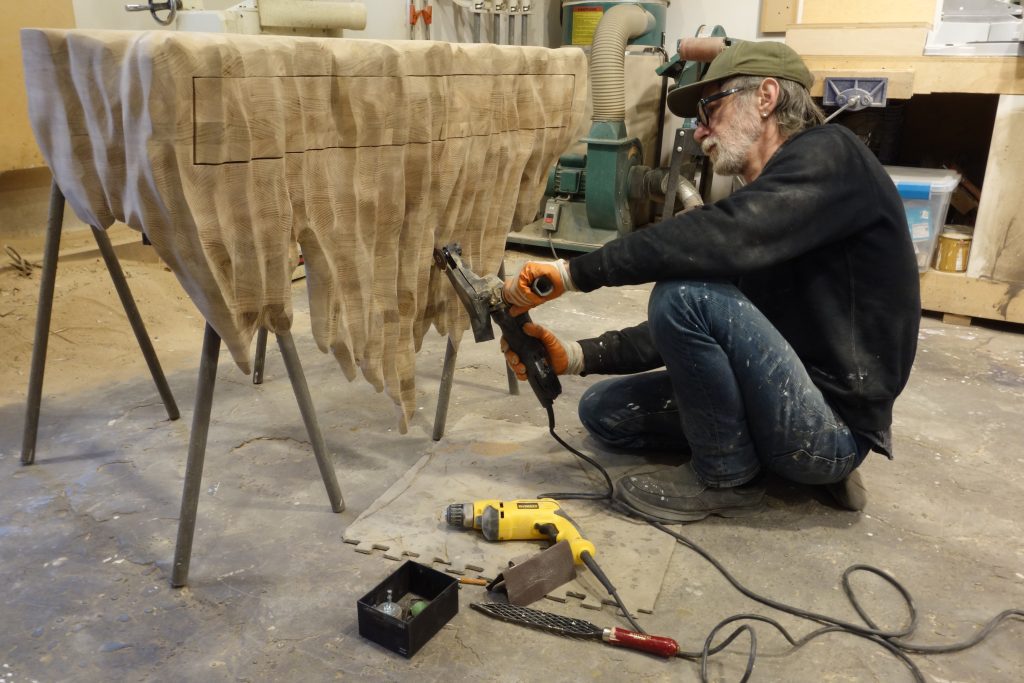

Humberto da Mata: Mastering the Art of Manipulating Materials
“I started to work with ceramics three years ago. I made a one-day class and then bought some clay and started to play with it in my studio. The material itself drove me to these organic forms. It is a very plastic mass and it kind of asks for the hand’s curves and shapes when it is modelled.”
View Humberto da Mata’s showroom, including the “Orgus V” collection
Before becoming a designer, Humberto da Mata was an architect. Unlike collectible design, architecture can be viewed as creatively challenging due to physical limitations, building requirements, and the scale at which it is done. For da Mata, his introduction to collectible design allowed him to shed these limitations. With this shift, not only could he let his imagination run wild and create what he wanted, but he was also able to do so with his own two hands. For makers, hands-on work offers an opportunity to not only develop a concept, but physically take part in making it become a reality.
As a designer, Humberto da Mata has truly embraced the opportunities that the field of collectible design has to offer. From his interest in shaping and moulding, to his fascination with colour, he is able to create pieces that go beyond any boundaries or regulations; pieces which are unique enough to be thought-provoking on their own, but which take on a whole new dimension when da Mata’s history with architecture and the juxtaposition between the two disciplines is taken into account.
Based in São Paulo, Brazil, da Mata’s practice focuses on design research, investigating different materials and techniques with the help of local artisans to create playful and unique collectible pieces. His latest collection, “Orgus V”, expands on his ceramic work from the last three years to experiment with new forms, textures, and material combinations. The final results are dynamic, tactile, and colourful, emphasising the hand of the maker through their organic forms.
How has your background in architecture and urban planning influenced your approach to collectible design?
I studied architecture and urban planning at UnB, Brasilia, where I was born. It is a city with one of the most famous groups of Brazilian modern architecture and a unique urban plan. To be born in this experiment is very singular. The city has a really strong presence, sometimes presented by its really big void areas.
Architecture was a natural choice for me. I didn’t know exactly what it was about, but I think that’s normal when you need to make this kind of choice at sixteen years old. I feel that I made the right choice. I really liked my course and it was a big introduction in how to develop a creative project, aligning it with technical and environmental possibilities and needs, and studying history and criticism of those same matters. It is a very complex subject and this is what makes it a great school.
I love architecture; I read about it, have a lot of architect friends and sometimes even make some projects for my family or myself. But I feel more comfortable with the design scale and all the experimentation it brings. Building something with my own hands is a very satisfying process.




What impact did working with the Campana brothers have on you and/or your practice?
I became an object designer after I met the Campana Brothers during a summer course at Boisbuchet, in France. At the time, I was working as an architect in Brasilia and was not very happy with my professional routine. This workshop showed me that dealing with small objects instead of architecture scale was much more liberating and exciting to me. I developed around eight projects during this week; it was a kind of cathartic experience. After this course, I moved to São Paulo and worked for the Campanas for a couple of months, and then I opened my own studio.
Humberto, Fernando, and their creative freedom [enlightened] me to the design practice, and after that I decided that this is what I want to do professionally.




There is quite a playful and organic nature to your ceramic work, for example in the “Orgus” and “Digitus” series. What draws you to these types of forms and colours?
I started to work with ceramics three years ago. I made a one-day class and then bought some clay and started to play with it in my studio. The material itself drove me to these organic forms. It is a very plastic mass and it kind of asks for the hand’s curves and shapes when it is modeled. The “Digitus” collection, for example, has a lot of fingers going out of the shapes and they have a really close relation to my fingers proportions, which were the main tool used to shape them.
Modeling paper pulp is similar in some ways. Using these materials together is very challenging, but they really fascinate me, the differences and similarities in technique and aesthetics are super intriguing.
About the colors, I have always been interested in the subject. I started researching color in university, when I decided to write an essay about color and architecture. Recently, I have done a small course on color history. In my work, color is used in a more experimental way. I studied some glazing techniques and was really amazed with all the chemical processes and possibilities when dealing with these substances that are mixed and then fused in the kiln. The “Digitus” collection shows the result from this glazing experimentation, it’s where I pushed the most use of different substances to make pieces that have at least three colors in the composition.
The paper pulp pieces are made with a recycled material that has a grey color, it changes according to the paper I use. They are painted with acrylic paint and resin after I apply a kaolin mortar on it. This mortar is very white and sometimes it is the final color. I started to use matte automotive varnish in this last collection, to produce utilitarian surfaces that are more resistant and durable.




What was the main inspiration behind your new collection, “Orgus V”?
The inspiration comes from various sources: the work itself (the day-to-day in the studio, learning to manipulate the materials in different ways) and the will to develop a work with more power.
I am also researching a lot of sculpture artists and how they deal with materiality in their work. I really admire the work from Alerne Shechet, Erika Verzutti, and Kenneth Price.
How does “Orgus V” build on your previous collections? How does it differ?
The “Orgus V” [collection] is part of the Orgus research that I have been developing in the last three years. The first collection was composed only of ceramic pieces and, last year, paper pulp started to make up part of this group, allowing me to explore new scales and proportions.
This collection is chapter five of this process, where you find more organic shapes, new typologies, more intense relations between different materials, and new experimentations of texture, composition, and scale. The interaction of the ceramic parts with the paper pulp changed in this collection. They are not only attached to one another. There are a series of perforations in the paper from where the ceramics come out, as if the interior of these pieces [are] filled with this ceramic mass.
Working with single pieces allows me to have this intense experimentation and keeps my studio more dynamic. This is what gives me the most pleasure.




Bio


Humberto da Mata is a design studio located in São Paulo, Brazil. Focused on design research with different materials and techniques, it produces and develops objects in a small production scale, with the help of artisans and small local industries.










